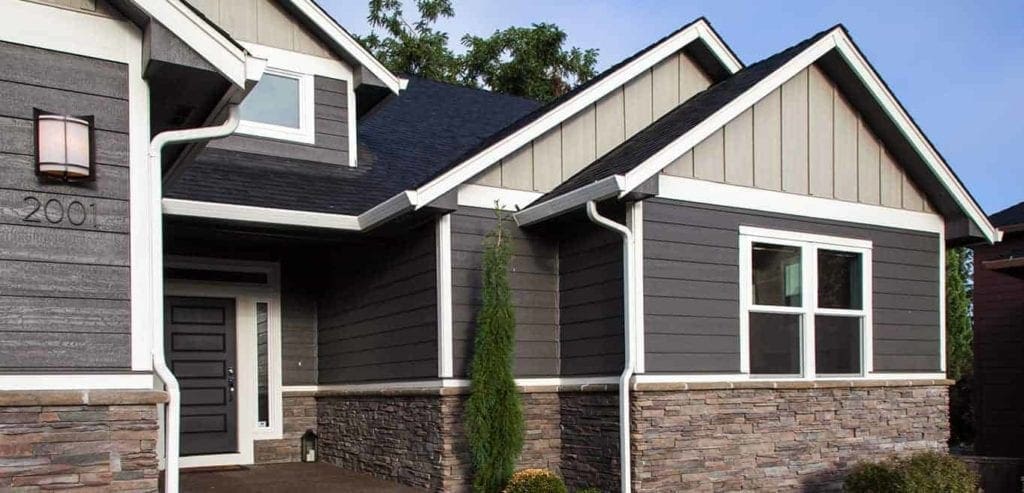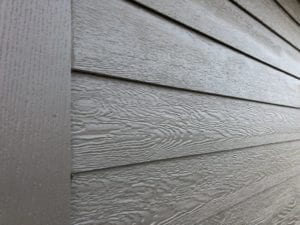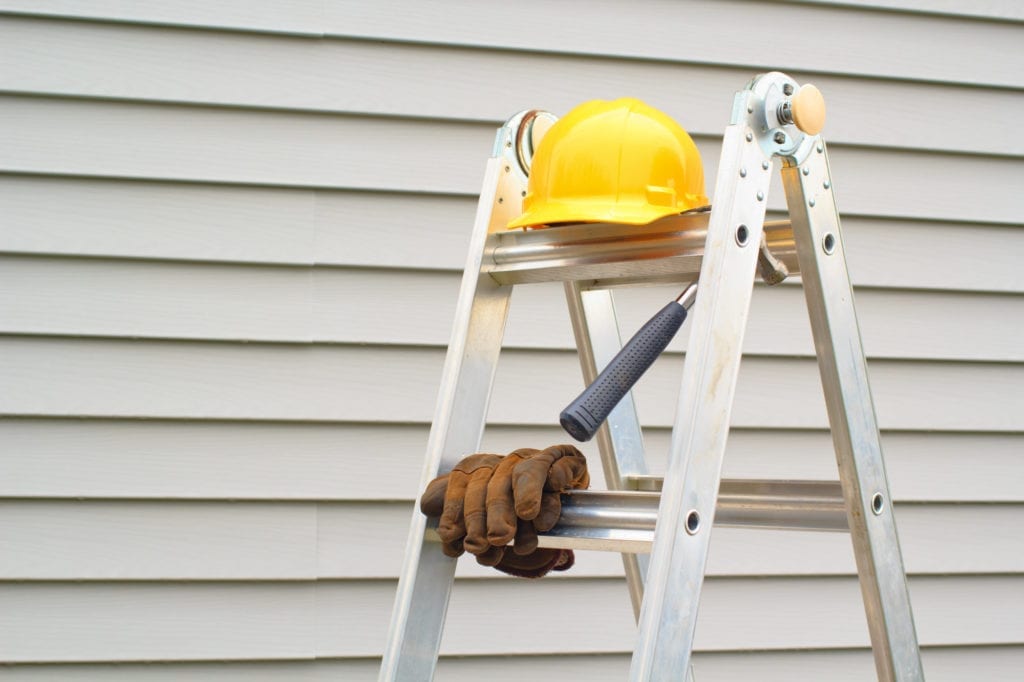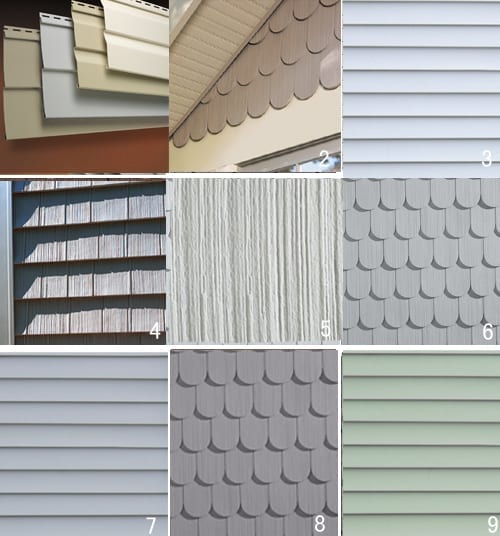
The Ultimate Guide to House Siding Replacement Costs in 2025
By Mark Anderson – Siding Expert with 25+ Years of Experience
If you’re considering replacing your home’s siding, you’re likely wondering what it’s going to cost and what options are available. As a siding professional with over 25 years in the industry and 12 years as the owner of my own siding business, I’ve helped thousands of homeowners improve their homes’ curb appeal, protect their investments, and increase property value. In this guide, I’ll break down the costs of replacing siding, including a detailed look at materials, installation, and how prices vary depending on your location.
Siding replacement is an important home improvement endeavor that can greatly enhance the aesthetic appeal and energy efficiency of a property. Whether the siding has been compromised due to weather-related damage or is merely displaying signs of age, understanding the appropriate timing and methods for replacement can yield significant benefits. This article examines the various justifications for replacing siding, the different materials available for selection, and provides an overview of anticipated costs in 2025. Prepare to elevate the exterior of your home.
What Is Siding Replacement?
Siding replacement is the process involving the removal of existing siding from a residence and the installation of new siding materials. This undertaking aims to enhance the property’s aesthetic appeal, improve energy efficiency, and provide protection against weather-related damage.

As a significant home improvement project, it can encompass various types of siding, including vinyl, wood, and fiber cement, each offering distinct advantages and associated costs. Recognizing the importance of siding replacement enables homeowners to make informed decisions regarding long-term investments in their properties, thereby ensuring both functionality and visual appeal.
FIND A LOCAL PROWhy Do You Need to Replace Your Siding?
Replacing siding is crucial for preserving both the integrity and aesthetic appeal of a home. It provides essential weather resistance and safeguards against potential structural damage resulting from moisture and pest infiltration.
Over time, siding materials may deteriorate due to aging or exposure to extreme weather conditions, which can result in higher maintenance costs and diminished energy efficiency. By investing in new siding, homeowners not only enhance the curb appeal of their property but also increase its overall value while ensuring long-term protection.
Damage from Weather and Age
Damage resulting from weather conditions and aging is a primary consideration for homeowners contemplating siding replacement. Factors such as harsh winds, rain, and snow can deteriorate siding over time, leading to expensive repairs and potential structural issues. Older siding materials may lose their protective qualities, rendering them more vulnerable to rot, mold, and pests, thereby necessitating replacement to ensure the safety and longevity of the home.
Extreme fluctuations in temperature can further exacerbate these issues, causing materials to expand and contract, which often results in cracking or warping. Additionally, heavy rainfall may result in prolonged moisture exposure, promoting the growth of mold and mildew, which in turn compromises the integrity of the structure.
Homeowners should remain vigilant in recognizing several signs of siding damage, including peeling paint, visible cracks, and the presence of mold. Disregarding these indicators can lead to more extensive damage, including structural problems that could incur significant repair costs.

Consequently, the timely replacement of aging siding not only enhances the aesthetic appeal of the home but also serves to protect against potential hazards.
Improve Energy Efficiency
Improving energy efficiency serves as a significant motivation for siding replacement, as outdated siding often lacks adequate insulation, resulting in elevated heating and cooling expenses. Modern siding materials are engineered to provide superior insulation and enhanced weather resistance, which can substantially decrease energy consumption and reduce maintenance costs over time. By investing in energy-efficient siding, homeowners not only improve their comfort but also contribute positively to environmental sustainability.
The selection of siding materials is crucial in determining a home’s overall energy efficiency. For example, fiber cement and insulated vinyl siding are noteworthy materials that deliver exceptional thermal performance. These options offer better insulation than traditional wood or aluminum siding, effectively minimizing heat transfer and maintaining a consistent indoor climate. As a result, homeowners may realize significant utility bill savings—often ranging from 10% to 20% annually—simply by upgrading to these energy-efficient alternatives.
- Fiber Cement: Durable and energy-efficient
- Insulated Vinyl: Enhances thermal resistance
- Wood: Provides aesthetic appeal but offers lesser insulation
As energy costs continue to escalate, making informed decisions regarding siding materials can lead to lower utility bills and a reduced carbon footprint.
Increase Curb Appeal
Increasing curb appeal is a critical consideration for homeowners contemplating siding replacement, as the exterior of a home significantly influences its overall aesthetic and market value. New siding can dramatically transform a property’s appearance, presenting a range of styles and colors that cater to individual preferences and neighborhood characteristics, thereby enhancing its appeal to potential buyers. According to Remodeling Magazine, investing in siding replacement often results in a high return on investment.

When selecting siding, it is essential to consider how various styles, such as wood, vinyl, and fiber cement, complement a home’s architectural features. For instance, traditional homes often benefit from the enduring charm of wood siding, while modern designs may enhance their aesthetic with sleek vinyl options. The choice of siding style should also take into account the home siding cost and the potential return on investment it offers.
Many homeowners tend to overlook the potential return on investment associated with siding replacement; high-quality materials can yield substantial returns, often recouping over 70% of costs upon resale.
- Wood Siding: Ideal for Colonial and Craftsman styles.
- Vinyl Siding: Versatile for a range of contemporary designs.
- Fiber Cement Siding: Suitable for both traditional and modern homes due to its durability.
By thoughtfully selecting the appropriate siding, homeowners can not only enhance their property value but also ensure that its visual appeal harmonizes with the surrounding community.
Save Me $$ on SidingHow Much Does Siding Replacement Cost in 2025?
In 2025, the cost of siding replacement is expected to vary considerably due to several factors, including the choice of material, the size of the residence, and the decision to employ professional installation versus opting for do-it-yourself methods.
The overall expenses associated with home siding can be categorized into material costs, installation fees, and any additional charges for labor or permits. Collaborating with American Home Contractors can help in obtaining a detailed cost breakdown for a more precise estimation.
Average Siding Replacement Costs by Home Size:
| Home Size (Sq. Ft.) | Levels | Architectural Style | Siding Coverage | Estimated Price |
|---|---|---|---|---|
| 1,300 | Single Story | Ranch | 1,500 sq. ft. | $12,401 |
| 1,600 | Single Story | Cottage | 1,200 sq. ft. | $9,743 |
| 2,000 | Double Story | Colonial | 2,600 sq. ft. | $21,967 |
| 2,500 | Double Story | Craftsman | 3,300 sq. ft. | $28,345 |
| 3,000 | Double Story | Contemporary | 3,900 sq. ft. | $34,014 |
Siding Costs by Material
| Siding Material | Cost Per Square Foot | National Average Cost Installed |
|---|---|---|
| Aluminum Siding | $1.55 – $7.12 | $2,903 – $14,100 |
| Brick Siding | $5.22 – $14.44 | $9,470 – $30,550 |
| Fiber Cement Siding | $5.12 – $11.43 | $10,700 – $23,600 |
| Hardie Board | $0.90 – $5.12 | $1,560 – $11,500 |
| Natural Stone Siding | $28 – $44.00 | $45,000 – 94,500 |
| Stucco Siding | $5.07 – $8.44 | $9,600 – $18,600 |
| Vinyl Siding | $1.23 – $8.59 | $2,120 – $15,200 |
| Wood Siding | $8.45 – $12.44 | $16,100 – $21,000 |
Therefore, it is crucial for homeowners to utilize a cost calculator to ensure accurate budgeting prior to commencing this significant home improvement endeavor.
Factors Affecting Cost
Several factors influence the cost of siding replacement, including the type of material selected, the size of the residence, and the choice between professional installation and do-it-yourself (DIY) methods. The type of material is particularly significant, as options such as vinyl, fiber cement, and wood vary considerably in terms of both price and durability. Additionally, installation costs can differ based on regional labor rates and the project’s complexity.

When contemplating siding replacement, homeowners must consider not only the material they wish to use but also the square footage of the home, as this can substantially affect the overall expenses. For example, a larger residence may require significantly more siding and labor, thereby increasing costs considerably.
- Vinyl siding, recognized for its affordability, typically ranges from $3 to $7 per square foot, though it has a shorter lifespan compared to other materials.
- Fiber cement, priced between $5 and $10 per square foot, provides both durability and aesthetic appeal, making it a favored choice among homeowners.
- Wood siding is often the most costly initially, with prices starting at approximately $7 per square foot, yet it imparts a classic charm.
While opting for professional installation may appear to be a higher upfront investment—generally adding about 20-30% to the total cost—it ensures a warranty and quality craftsmanship. Conversely, DIY installation methods can lower labor expenses, but homeowners must consider their skill level and the potential costs associated with errors, which could ultimately negate any savings. Choosing professional help might be a good investment in the long run, especially for intricate projects.
COMPARE QUOTESAverage Cost for Different Types of Siding
The average cost of siding replacement varies considerably based on the selected siding material. Vinyl siding is frequently regarded as the most economical option, while materials such as natural stone or brick are typically associated with significantly higher costs. It is essential for homeowners to consider not only the price of the materials but also additional factors, including labor and installation fees linked to each type of siding. Utilizing a cost calculator can aid in understanding the cost breakdown for different siding types.
When assessing various siding materials, homeowners often discover that prices can vary between regions and suppliers, making it imperative to obtain multiple quotes for comparison. For instance, vinyl siding may range from $2 to $7 per square foot, which is an important consideration when determining the vinyl siding cost. In contrast, fiber cement can cost between $5 to $10 per square foot, and natural wood siding may vary from $3 to $12 per square foot depending on its quality and type. Engaging with a reputable contractor can ensure accurate estimates and quality work.
Furthermore, the following pricing details are noteworthy:
- Brick is generally the most expensive, ranging from $6 to $16 per square foot.
- Aluminum siding is typically available for approximately $3 to $8 per square foot.
- Vinyl siding cost is usually between $2 to $7 per square foot, making it a budget-friendly option.
Homeowners should not only consider initial costs but also evaluate the lifespan and maintenance requirements of each material. For example, vinyl siding is recognized for its low maintenance needs, while wood siding necessitates periodic painting or staining. Additionally, using a cost calculator can help estimate the house siding cost based on factors like house size and material type.
Taking these factors into account, the selection of the appropriate siding material can significantly influence the long-term value and curb appeal of a home. It is advisable to perform thorough market research and possibly consult the National Association of Home Builders (NAHB) or Remodeling Magazine for current trends and cost breakdowns by material.
What are the Different Types of Siding Materials?
When contemplating a siding replacement, homeowners are presented with a diverse selection of siding materials, each providing unique advantages, aesthetic qualities, and levels of durability. It’s important to consider the installation cost and whether it will be a DIY installation or require professional help.
Commonly available options include vinyl, fiber cement, wood, stucco, aluminum, brick, and natural stone. Each of these siding types offers different energy efficiency and maintenance costs.
This variety enables homeowners to select the most suitable option that aligns with their preferences, budgetary considerations, and the specific climate characteristics of their location.
Vinyl Siding
One of the most popular home siding options due to its versatility and low cost. National Association of Home Builders (NAHB) often recommends it for its excellent energy efficiency.
Vinyl siding is among the most favored options for homeowners due to its affordability, low maintenance requirements, and excellent resistance to weather conditions. This synthetic material is available in a wide array of colors and styles, making it a versatile choice that enhances the curb appeal of any residence while providing durability against various environmental elements.
When evaluating vinyl siding, it is crucial to consider both its benefits and drawbacks. On the positive side, this type of siding is significantly more cost-effective compared to alternatives such as wood or fiber cement, making it accessible to a broader range of homeowners. Additionally, its energy efficiency can result in savings on heating and cooling expenses, particularly when paired with appropriate insulation.
- Cost-effective: The initial installation costs are lower than those of traditional materials.
- Low Maintenance: It requires minimal upkeep, primarily consisting of occasional cleaning.
- Durability: Vinyl siding is resistant to peeling and fading, thereby extending its lifespan.
However, there are notable disadvantages to consider. In extreme climate conditions, vinyl siding may crack or warp, which can diminish its longevity. While professional installation is highly recommended, it can also be approached as a suitable DIY project for individuals with experience in home improvement, potentially reducing the overall house siding cost.
Wood Siding
A timeless choice that can enhance the beauty of any property but requires substantial upkeep to prevent structural damage from the elements.
Wood siding presents an aesthetic appeal that many homeowners find desirable, offering a natural and timeless appearance that can enhance the overall beauty of any property. However, it necessitates regular maintenance to avert issues such as warping, rot, and insect damage, all of which can adversely affect its durability and weather resistance.

While the charm of wood siding is undeniable, potential buyers should carefully evaluate both the advantages and disadvantages before making a decision.
- Benefits: Wood siding is environmentally friendly, as it is a renewable resource. It offers a variety of styles, including clapboard, shingles, and board-and-batten, allowing homeowners to select an option that aligns with their architectural vision.
- Cost Considerations: In terms of expenses, the initial installation costs may be higher compared to alternatives like vinyl; however, many property owners appreciate the long-term value that wood siding provides, as it has the potential to enhance property resale value.
- Maintenance Requirements: Regular upkeep is essential; painting or staining is required every few years to maintain its appearance and protect it from the elements, which may be a consideration for homeowners with limited time for maintenance. Seeking professional help for this maintenance can ensure longevity.
Ultimately, the decision to choose wood siding should reflect both aesthetic preferences and a commitment to its ongoing upkeep, ensuring that the investment remains both beautiful and sustainable over time.
Fiber Cement Siding
Fiber cement siding is a highly durable option that effectively combines the aesthetic appeal of wood with the resilience of cement, making it an excellent choice for homeowners seeking long-lasting protection against various environmental elements. Although its initial cost may exceed that of vinyl or wood alternatives, the durability and low maintenance requirements associated with fiber cement siding often render it a cost-effective investment over time.
This material possesses exceptional characteristics that distinguish it within the competitive siding market, often cited by Remodeling Magazine for its good investment potential:
- Weather Resistance: Fiber cement siding can endure harsh conditions, including extreme heat, heavy rainfall, and hail.
- Fire Resistance: Unlike traditional wood siding, it is non-combustible, offering significant safety benefits and peace of mind.
- Environmental Benefits: The majority of options are manufactured with sustainable materials, aligning with the values of eco-conscious homeowners.
When evaluating costs, it is essential to consider the longevity and reduced maintenance that fiber cement siding provides. Many homeowners find that the initial investment is well justified over the long term, solidifying its status as a favored choice in contemporary construction. Considering the average cost and potential for return on investment, it remains a strong contender in the siding market.
Aluminum Siding
Aluminum siding is widely recognized for its affordability and low maintenance costs, positioning it as a practical option for budget-conscious homeowners. Its resistance to weather conditions and ability to withstand corrosion render it suitable for various climates; however, it may not possess the same aesthetic appeal as wood or vinyl alternatives.
When considering the installation of aluminum siding, it is essential to evaluate both the benefits and drawbacks. On one hand, it is typically less expensive than other materials, resulting in significant savings upfront. Additionally, aluminum siding requires minimal upkeep; a simple wash with soap and water can effectively maintain its appearance.
Aesthetic considerations are also important. Unlike wood or vinyl, aluminum siding may lack the warmth and texture that some homeowners seek. Furthermore, it may be more susceptible to dents, which could be a concern in regions prone to hail or severe storms.
Advantages:
- Affordable
- Low maintenance
- Durable against weather
Disadvantages:
- Less aesthetic appeal
- Potential for dents
Popular finishes include a variety of colors and textures that can mimic more traditional materials, allowing for increased customization while still reaping the benefits of aluminum. When considering the home siding cost, aluminum offers a balance between cost and durability.
Brick Siding
Brick siding is renowned for its durability and timeless aesthetic appeal, providing homeowners with a classic appearance coupled with long-lasting performance. While the initial cost of brick siding is generally higher than that of other siding materials, its low maintenance requirements and impressive resistance to weathering often make it a valuable investment for many homeowners.
When evaluated comprehensively, the advantages of brick siding significantly outweigh any disadvantages. It is often referred to as a good investment due to its high return on investment and minimal maintenance costs.
- Durability: Brick siding offers remarkable resistance to fire, moisture, and insect damage, ensuring a lasting exterior.
- Maintenance: It requires minimal upkeep, typically necessitating only occasional cleaning to preserve its visual appeal.
- Aesthetic Versatility: This material enhances a range of architectural styles, offering an attractive aesthetic option.
- Cost Considerations: Although the initial investment is considerable, many homeowners find that reduced repair and energy costs provide better long-term value.
- Return on Investment: The installation of brick siding often leads to a positive increase in property values, making it an appealing choice for homeowners.
In conclusion, brick siding represents an exceptional opportunity for individuals seeking to enhance the exterior of their homes, achieving a harmonious balance between beauty and practicality.
Stucco Siding
Stucco siding presents a distinctive aesthetic appeal, particularly in warmer climates, offering a stylish and textured appearance that enhances the exterior of a home. According to market research, stucco performs well in terms of energy efficiency and weather resistance.
Notably, stucco is recognized for its design versatility, available in a variety of colors and finishes, which enables homeowners to customize the appearance of their properties according to their personal preferences.
Plus its visually appealing attributes, stucco siding is engineered to endure harsh weather conditions, especially in sunny or arid regions where other materials may succumb to fading or deterioration. Its low maintenance and durability make it a preferred choice for many homeowners.
- It effectively resists mold and mildew, making it a preferred choice for individuals residing in humid environments.
- However, without proper maintenance, stucco can develop cracks that require prompt repairs to prevent further water intrusion, which could lead to more extensive structural damage.
When considering costs, stucco is typically more affordable than high-end materials such as brick but may be more expensive than vinyl siding. Nevertheless, the long-term durability of stucco can offset initial expenses, particularly in climates susceptible to extreme temperatures.
Therefore, homeowners should conduct a thorough assessment of their local weather conditions and the potential for maintenance before reaching a final decision.
Stone Siding
Stone siding is recognized as one of the most durable and aesthetically pleasing siding options available, offering a natural and sophisticated appearance that can significantly enhance a home’s value. While the initial cost of stone siding may be considerably higher than that of other materials, its longevity and minimal maintenance requirements often justify the investment for homeowners seeking both quality and beauty.
Upon considering the various types of stone available, including limestone, granite, and slate, it is evident that homeowners have a wide range of choices to accommodate different architectural styles. The resilience of stone siding against harsh weather conditions, pests, and decay further reinforces its reputation as a robust investment.
Prospective buyers should also take into account the installation complexities associated with this material, particularly the necessity for a skilled contractor and adequate infrastructure to support the weight of the stone.
- Durability: Typically lasts for decades, reducing the need for frequent replacements.
- Aesthetic Appeal: Provides a unique and upscale appearance that enhances curb appeal.
- Cost Effectiveness: Although initially more expensive, its durability can lead to savings over time.
When compared to other siding options, such as vinyl or wood, stone siding not only stands out in terms of beauty but also often outlasts these materials, providing a significant advantage in both home equity and personal satisfaction.
Save Me $$ on SidingHow to Choose the Right Siding Material for Your Home?
Selecting the appropriate siding material for a residence requires careful consideration of several factors, including budget, aesthetic preferences, climate, and maintenance requirements.
Given the wide array of options available, such as vinyl, wood, and fiber cement, homeowners should thoroughly evaluate the long-term costs and benefits associated with each type of material. This evaluation is essential to ensure that their investment not only meets their immediate needs but also enhances the overall value of their property.
What Are the Steps Involved in Siding Replacement?
The process of siding replacement encompasses several essential steps that are critical to achieving a successful and efficient installation. This process begins with a comprehensive inspection of the existing siding and preparation of the underlying structures.
Engaging professional assistance can facilitate this process and ensure high-quality results, encompassing everything from the removal of the old siding to the installation of new materials. This not only enhances the aesthetic appeal of the home but also improves its overall functionality.
Inspection and Preparation
The initial step in the process of siding replacement involves a thorough inspection of the existing siding. This assessment is critical for identifying any underlying issues that may require attention, such as structural damage or moisture-related problems.
Preparation for the installation of new siding includes ensuring that the home is adequately prepared, which may involve repairing any damaged areas, removing old siding, and addressing insulation requirements.
During this essential inspection phase, homeowners should be vigilant for signs of wear and tear, including cracks, warping, or discoloration, as these indicators can suggest deeper issues that may compromise the overall integrity of the home. It is also imperative to examine areas for water damage, particularly around windows and door frames, as well as to assess the potential for pest infestations.
Common issues frequently identified during inspections include deteriorated flashing, which can lead to leaks, and compression on the sheathing that necessitates immediate attention.
Ahead of the installation of new siding, thorough preparations are essential. Homeowners are advised to consider engaging the services of professionals who can conduct a comprehensive assessment and offer guidance on necessary repairs. Tasks to be undertaken may include:
- Ensuring that substructures are sound and adequately insulated
- Removing old siding and debris to establish a clean work area
- Evaluating the need for additional moisture barriers
By effectively addressing these concerns, homeowners can prevent further damage, ultimately resulting in significant time and cost savings in the long term.
Removing Old Siding
Removing old siding is a crucial step in the replacement process, as it provides an opportunity for a fresh start and ensures that any underlying issues are addressed prior to the installation of new materials. Homeowners may choose to undertake this task themselves or engage professional services, which can expedite the process and enhance safety during removal.
In terms of the safe removal of siding, employing appropriate techniques and tools is essential. Proper handling not only prevents damage to the underlying structures but also minimizes the risk of injury during the process. Utilizing a pry bar, utility knife, and suitable safety gear, such as gloves and goggles, can significantly enhance the overall effectiveness of the task.
While some homeowners may consider a DIY approach, it is important to carefully assess the pros and cons:
- Time: Professionals typically work more efficiently, allowing homeowners to concentrate on other important responsibilities.
- Safety: Experienced contractors are trained to manage hazardous materials and navigate potential structural concerns more effectively than the average homeowner.
- Effectiveness: Professionals possess a discerning eye for identifying hidden issues that may go unnoticed during a DIY removal.
Ultimately, the decision between a DIY approach and hiring experts should take these factors into account to ensure a successful siding replacement.
Repairing or Replacing Underlying Structures
Repairing or replacing the underlying structures is essential following the removal of old siding, as this step directly influences the longevity and effectiveness of the new siding installation. Neglecting this critical process can lead to significant issues that undermine both the aesthetic appeal and durability of the home.
Structural inspections should prioritize the identification of any rotting wood, damaged framing, or compromised foundation elements that may require immediate attention. The installation of appropriate moisture barriers is vital for preventing water infiltration, which can subsequently lead to mold growth and other costly repairs. Additionally, insulation must be assessed; inadequate or damaged insulation can diminish energy efficiency and overall comfort levels within the property.
Given the complexity of these repairs, enlisting professional assistance is strongly recommended to ensure that all work adheres to safety regulations and maintains the building’s structural integrity.
- Thorough Inspection: Homeowners should commence with a detailed inspection of the underlying structures.
- Addressing Structural Damage: Any indications of rot or weakness must be repaired prior to proceeding.
- Moisture Barriers: The installation of moisture barriers is essential for protection against water infiltration.
- Insulation Checks: Existing insulation should be evaluated for its effectiveness.
- Professional Assistance: Engaging experts ensures adherence to safety and structural standards.
Installation of New Siding
The installation of new siding represents the final and most critical phase of the replacement process, during which the selected siding material is meticulously fitted to the home to ensure both durability and aesthetic appeal. Engaging professional assistance during this stage can significantly enhance the quality of the installation, as experienced contractors possess the expertise to navigate the complexities associated with different siding styles and materials.
Proper installation is essential not only for visual appeal but also for long-term performance. It is advisable to consider the following key steps for various siding materials:
- Vinyl Siding: Ensure that the wall surface is clean and dry prior to installation. Install moisture barriers to mitigate the risk of water damage.
- Wood Siding: Utilize stainless steel nails to prevent rust, and ensure proper ventilation to minimize moisture accumulation.
- Fiber Cement: Adhere to manufacturer guidelines regarding spacing and joints to avoid potential cracking or warping over time.
While some homeowners may be inclined to undertake this project independently, hiring professionals offers numerous advantages. Precision is vital in achieving a watertight seal, thereby preventing issues such as mold and structural damage. Additionally, a warranty from professional installers provides reassurance, safeguarding against potential future repair costs. Ultimately, a careful evaluation of the pros and cons will assist homeowners in achieving a successful siding installation. Considering the house size and material type can also play a significant role in the project’s outcome.
Finishing Touches and Clean Up
Following the installation of new siding, the finishing touches and clean-up phase are essential to ensure that the project achieves a polished appearance and meets the homeowner’s expectations. This stage involves sealing any gaps, applying caulking, and ensuring the removal of all debris from the site, thereby enhancing the overall aesthetic of the home. Proper attention to this process can also improve the siding’s weather resistance and energy efficiency.

A meticulous approach to the finishing touches not only elevates the visual appeal but also extends the lifespan of the siding. It is imperative to ensure that all joints and seams are adequately sealed to prevent moisture intrusion, which could lead to mold growth or structural damage over time. The application of caulk around windows and doors provides an additional layer of protection against the elements, safeguarding the investment in siding replacement.
The clean-up process significantly contributes to the project’s success; any remnants left behind may serve as a reminder of incomplete work and detract from the home’s new appearance. A thorough clean-up ensures the following:
- All excess materials are disposed of properly.
- Debris is cleared away, leaving the landscape tidy.
- The new siding is free from dirt or dust that might diminish its value.
Ultimately, dedicating time and effort to these final steps not only guarantees homeowner satisfaction but also reinforces the craftsmanship and quality of the installation.
Save Me $$ on SidingHow to Save Money on Siding Replacement?
Cost savings on siding replacement can be attained through several strategies, including the comparison of quotes from multiple contractors, the selection of mid-range siding materials, and the consideration of do-it-yourself installation options. Utilizing a cost calculator can assist in understanding the average cost of various siding types and help in making informed decisions.
By thoroughly evaluating these choices and understanding the overall financial implications, homeowners can make informed decisions that optimize their budget while ensuring a quality siding installation.
Compare Quotes from Different Contractors
One of the most effective methods for reducing expenses associated with siding replacement is to compare quotes from various contractors. This practice enables homeowners to identify competitive pricing and the services offered. Not only does this process assist in securing the best deal, but it also ensures that homeowners are well-informed about the diverse options available for their siding projects.
Obtaining multiple quotes is a critical step in making an informed decision, as it provides valuable insights into the range of services available and highlights the specialties of individual contractors. This market research can reveal the differences in house siding costs and the potential return on investment for different materials.
When evaluating contractors, it is essential to consider their reputation and previous projects, which can often be assessed through online reviews and references. Additionally, seeking recommendations from friends or family can enhance trust in the decision-making process.
- Look for contractors with favorable ratings on platforms such as Yelp or Angie’s List.
- Verify that they possess relevant certifications and licenses.
During the negotiation of pricing, it is advisable to openly discuss one’s budget. Many contractors may be willing to adjust their pricing if they recognize the potential for repeat business or referrals.
Engaging in a constructive dialogue can lead to more favorable terms while ensuring that the quality of materials and workmanship remains a primary focus. For example, discussing vinyl siding cost and installation costs can help in identifying the best options within one’s budget.
Choose a Mid-range Siding Material
Selecting a mid-range siding material represents a strategic approach to achieving a balance between quality and cost, enabling homeowners to enhance their property’s appearance without incurring excessive expenses.
Such materials frequently offer a variety of advantages that can significantly improve not only the aesthetic appeal of the property but also its marketability. For instance, options like vinyl siding and fiber cement are recognized for their remarkable durability and low maintenance requirements.
- Vinyl siding demonstrates resistance to rust and rot, providing enduring protection against environmental factors.
- Conversely, fiber cement successfully replicates the appearance of wood while offering resistance to pests and fire, thereby enhancing its reliability.
By opting for these materials, homeowners may realize reduced long-term expenses associated with repairs and maintenance, ultimately contributing to an increase in overall property value. The visual appeal of these mid-range options often attracts prospective buyers, making them a prudent investment for individuals seeking to improve their home’s exterior. Additionally, selecting materials like vinyl, fiber cement, and natural stone can offer significant benefits in terms of durability and aesthetic appeal.
Consider DIY Options for Home Siding
Considering DIY options for siding installation can result in significant cost savings, as homeowners can eliminate the labor expenses associated with hiring professionals. It is essential to evaluate whether the required skill level and tools for the project are compatible with the homeowner’s capabilities to ensure a successful outcome.
Engaging in a DIY siding installation presents numerous advantages, particularly in terms of cost savings. Homeowners may experience a sense of accomplishment from completing the project independently, as well as the potential for increasing their property’s value. However, the risks associated with improper installation can be considerable; mistakes may lead to water damage or diminished energy efficiency, resulting in costly repairs. Before starting, it’s advisable to review tutorials and cost breakdowns to better understand the project’s scope.
Pros:
- Reduced expenses
- Increased personal satisfaction
- Flexible scheduling
Cons:
- Potential for errors
- Necessity of knowledge regarding building codes
- Time-consuming efforts that may not yield optimal results
For those considering this approach, it is crucial to assemble the necessary tools, including a level, measuring tape, and a nail gun. Reliable resources, such as instructional videos or community workshops, can be invaluable in ensuring that the job is completed proficiently. Additionally, consulting with professionals about material types and siding styles can help in making informed decisions during the DIY installation.
FIND A PROFrequently Asked Questions
What factors will affect the siding replacement cost in 2025?
The cost of siding replacement in 2025 will depend on several factors such as the size of the house, type of siding material chosen, labor costs, and any additional features or customizations desired.
Is it recommended to replace siding in 2025 or wait until a later date?
It is ultimately up to the homeowner, but it may be more cost-effective to replace siding in 2025 rather than waiting. The cost of materials and labor may continue to increase over time, making it more expensive in the future.
What are the most popular siding materials for 2025?
The most popular siding materials for 2025 are projected to be vinyl, fiber cement, and wood. These materials are cost-effective, durable, and have a variety of design options to choose from.
Are there any eco-friendly siding materials that will be popular in 2025?
Yes, there are several eco-friendly siding materials that are expected to gain popularity in 2025. These include recycled vinyl, engineered wood, and natural stone. These materials not only reduce the environmental impact, but also have long lifespans.
Will there be any technological advancements in siding replacement that could affect the home siding cost in 2025?
Yes, there are already technological advancements being made in the siding industry, such as pre-painted panels and improved insulation. These advancements may affect the cost of siding replacement in 2025, as they may require specialized labor and materials. According to Remodeling Magazine, these innovations could lead to increased energy efficiency and reduced maintenance costs.
Are there any ways to save on house siding costs in 2025?
Yes, there are several ways to save on siding replacement costs in 2025. Homeowners can choose more cost-effective materials, opt for basic designs, and shop around for the best deals on labor and materials. Utilizing resources from the National Association of Home Builders (NAHB) and American Home Contractors can also provide valuable insights. It is important to properly maintain the new siding to avoid costly repairs in the future.
